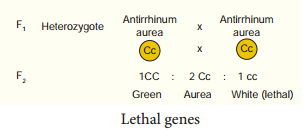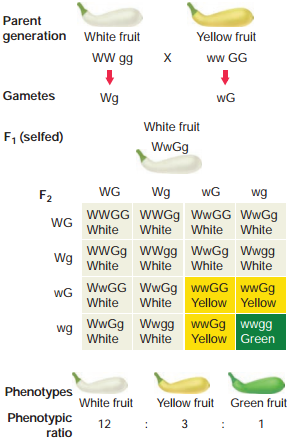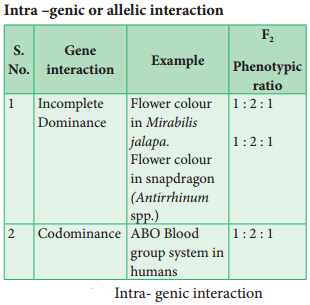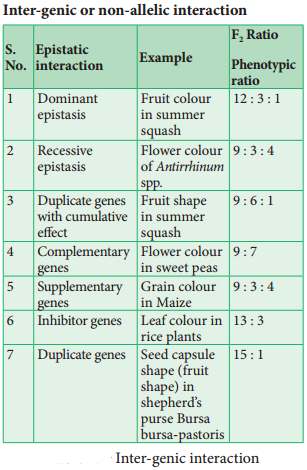Learninsta presents the core concepts of Biology with high-quality research papers and topical review articles.
Interaction Of Genes – Intragenic And Intergenic Incomplete Dominance, Lethal Genes, Epistasis
Interactions take place between the alleles of the same gene i.e., alleles at the same locus is called intragenic or intralocus gene interaction. It includes the following:
- Incomplete dominance
- Codominance
- Multiple alleles
- Pleiotropic genes are common examples for intragenic interaction.
Incomplete dominance – No blending of genes
The German Botanist Carl Correns’s (1905) Experiment – In 4 O’ clock plant, Mirabilis jalapa when the pure breeding homozygous red (R1R1) parent is crossed with homozygous white (R2R2), the phenotype of the F1 hybrid is heterozygous pink (R1R2). The F1 heterozygous phenotype differs from both the parental
homozygous phenotype.
This cross did not exhibit the character of the dominant parent but an intermediate colour pink. When one allele is not completely dominant to another allele it shows incomplete dominance. Such allelic interaction is known as incomplete dominance.
Such allelic interaction is known as incomlete dominance. F1 generation produces intermediate phenotype pink coloured flower. When pink coloured plants of F1 generation were interbred in F2 both phenotypic and genotypic ratios were found to be identical as 1 : 2 : 1(1 red : 2 pink : 1 white). Genotypic ratio is 1 R1R1 : 2 R1R2 : 1 R1R2. From this we conclude that the alleles themselves remain discrete and unaltered proving the Mendel’s Law of Segregation.
The phenotypic and genotypic ratios are the same. There is no blending of genes. In the F2 generation R1 and R2 genes segregate and recombine to produce red, pink and white in the ratio of 1 : 2 : 1. R1 allele codes for an enzyme responsible for the formation of red pigment. R2 allele codes for defective enzyme. R1 and R2 genotypes produce only enough red pigments to make the flower pink.
Two R1R1 are needed for producing red flowers. Two R2R2 genes are needed for white flowers. If blending had taken place, the original pure traits would not have appeared and all F2 plants would have pink flowers. It is very clear that Mendel’s particulate inheritance takes place in this cross which is confirmed by the reappearance of original phenotype in F2.

Codominance (1 : 2 : 1)
This pattern occurs due to simultaneous (joint) expression of both alleles in the heterozygote – The phenomenon in which two alleles are both expressed in the heterozygous individual is known as codominance. Example: Red and white flowers of Camellia, inheritance of sickle cell haemoglobin, ABO blood group system in humanbeings. In humanbeings, IA and IB alleles of I gene are codominant which follows Mendels law of segregation.
The codominance was demonstrated in plants with the help of electrophoresis or chromatography for protein or flvonoid substance. Example: Gossypium hirsutum and Gossypium sturtianum, their F1 hybrid (amphiploid) was tested for seed proteins by electrophoresis. Both the parents have different banding patterns for their seed proteins. In hybrids, additive banding pattern was noticed. Their hybrid shows the presence of both the types of proteins similar to their parents.
The heterozygote genotype gives rise to a phenotype distinctly different from either of the homozygous genotypes. The F1 heterozygotes produce a F2 progeny in a phenotypic and genotypic ratios of 1 : 2 : 1.
Lethal genes
An allele which has the potential to cause the death of an organism is called a “Lethal Allele”. In 1907, E. Baur reported a lethal gene in snapdragon (Antirrhinum sp.). It is an example for recessive lethality. In snapdragon there are three kinds of plants.
- Green plants with chlorophyll. (CC)
- Yellowish green plants with carotenoids are referred to as pale green, golden or aurea plants (Cc)
- White plants without any chlorophyll. (cc)
The genotype of the homozygous green plants is CC. The genotype of the homozygous white plant is cc.
The aurea plants have the genotype Cc because they are heterozygous of green and white plants. When two such aurea plants are crossed the F1 progeny has identical phenotypic and genotypic ratio of 1 : 2 : 1 (viz. 1 Green (CC) : 2 Aurea (Cc) : 1 White (cc)) Since the white plants lack chlorophyll pigment, they will not survive. So the F2 ratio is modifid into 1 : 2. In this case the homozygous recessive genotype (cc) is lethal.

The term “lethal” is applied to those changes in the genome of an organism which produces effects severe enough to cause death. Lethality is a condition in which the death of certain genotype occurs prematurely. The fully dominant or fully recessive lethal allele kills the carrier individual only in its homozygous condition. So the F2 genotypic ratio will be 2 : 1 or 1 : 2 respectively.
Pleiotropy – A single gene affects multiple traits
In Pleiotropy, the single gene affcts multiple traits and alter the phenotype of the organism. The Pleiotropic gene inflences a number of characters simultaneously and such genes are called pleiotropic gene were crossed with a variety of peas having white flowers, light coloured seeds and no spot on the axils of the leaves, the three traits for flwer colour, seed colour and a leaf axil spot all were inherited together as a single unit. Another example is: sickle cell anemia.
Intergenic gene interactions
Interlocus interactions take place between the alleles at different loci i.e between alleles of diffrent genes. It includes the following:
Dominant Epistasis
It is a gene interaction in which two alleles of a gene at one locus interfere and suppress or mask the phenotypic expression of a different pair of alleles of another gene at another locus. Th gene that suppresses or masks the phenotypic expression of a gene at another locus is known as epistatic.
The gene whose expression is interfered by non-allelic genes and prevents from exhibiting its character is known as hypostatic. When both the genes are present together, the phenotype is determined by the epistatic gene and not by the hypostatic gene.
In the summer squash the fruit colour locus has a dominant allele ‘W’ for white colour and a recessive allele ‘w’ for coloured fruit. ‘W’ allele is dominant that masks the expression of any colour. In another locus hypostatic allele ‘G’ is for yellow fruit and its recessive allele ‘g’ for green fruit. In the first locus the white is dominant to colour where as in the second locus yellow is dominant to green.
When the white fruit with genotype WWgg is crossed with yellow fruit with genotype wwGG, the F1 plants have white fruit and are heterozygous (WwGg). When F1 heterozygous plants are crossed they give rise to F2 with the phenotypic ratio of 12 white : 3 yellow : 1 green

Since W is epistatic to the alleles ‘G’ and ‘g’, the white which is dominant, masks the effect of yellow or green. Homozygous recessive ww genotypes only can give the coloured fruits (4/16). Double recessive ‘wwgg’ will give green fruit (1/16). The Plants having only ‘G’ in its genotype (wwGg or wwGG) will give the yellow fruit(3/16).
Intra – genic or allelic interaction

